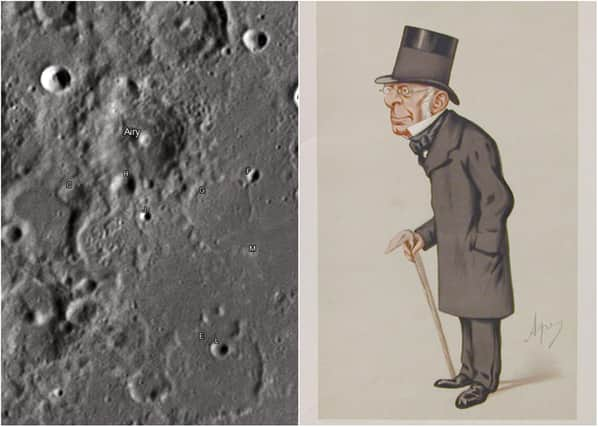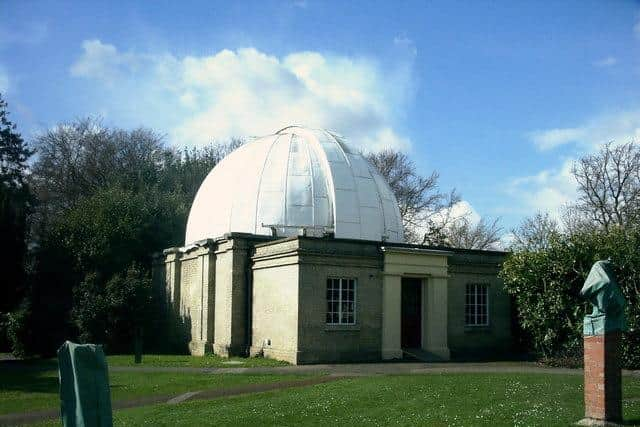Is Sir George Alnwick's most famous son?


Name a famous person from Alnwick Some might say Harry Hotspur, whose statue stands opposite the ‘Dirty Bottles’. Though strongly linked with Alnwick, Harry was born at Warkworth.
Others might think of Lucy Bronze, the England and Manchester City football player, but Lucy was born at Berwick-upon-Tweed.
Advertisement
Hide AdAdvertisement
Hide AdFew will mention Sir George Biddell Airy, who was actually born in the town. He left at the age of four, but surely has a good claim to be remembered as one of our greats.


Today, the only local memorial we have is the blue plaque on the wall of number five, Grosvenor Terrace, but there are other memorials which you can see, though you’ll need a good telescope!
George Airy was born here in 1801. In 1835, 30 years after leaving Alnwick, he became Astronomer Royal, a position he held until 1881.
The list of his scientific work is long. On the moon, there is a crater named Airy, while on Mars there are two craters bearing his name, one sitting within the other.
Advertisement
Hide AdAdvertisement
Hide AdThe smaller of these, called Airy-0, defines the prime meridian of that planet, the equivalent of our Greenwich meridian.
After leaving Alnwick, George attended Colchester Royal Grammar School. It was recorded that he was “an introverted but not shy child” and “even for the time and especially for his circumstances, a young snob”, but that “he overcame some of the dislike of his schoolmates by his great skill and inventiveness in the construction of peashooters and other such devices”.
At school, he was particularly noted for his memory. In one examination he is supposed to have repeated over two thousand lines of Latin verse.
From Colchester, in 1819, he went to Trinity College, Cambridge, where his career as a mathematician and astronomer was launched. By 1828 he was Director of the newly established Cambridge Observatory, where, in 1833, he was able to design a mounting for a fine 12-inch telescope that had been presented by the Duke of Northumberland.
Advertisement
Hide AdAdvertisement
Hide AdIn its day, this telescope was one of the largest in the world. It is still in place at Cambridge, and although it is no longer employed for scientific work, it is still regularly used for observations by the University Astronomical Society and members of the public.
In 1830, he carried out calculations to determine the difference between the diameter of the earth at the equator and at the pole, effectively working out how non-spherical the earth actually is.
This might seem a bit academic, but it is fundamental to accurate mapping. Despite more accurate measurements becoming available, his ‘Airy geoid’ measurements are still used today by the Ordnance Survey.
Known as the OSGB36 projection, this more accurately reflects the local situation in the UK.
In 1835, Airy was appointed as Astronomer Royal.
Advertisement
Hide AdAdvertisement
Hide AdHe took over the Greenwich Observatory at a time when it was, in his words’ “in a queer state”, after years of neglect. He worked energetically to get things in order, getting new equipment installed and formalising the astronomical observations.
By 1859, the organisation was unrecognisable, with a wide range of new instruments being available to the staff.
One of Airy’s most lasting legacies was the establishment of the prime meridian at Greenwich, though this was, to some extent, an accidental circumstance.
The prime meridian depended on the installation of a transit circle, a telescope that could only move in a north-south direction.
Advertisement
Hide AdAdvertisement
Hide AdThe Greenwich meridian had moved a number of times as new transit circle telescopes had been installed in different positions around the Greenwich site, but it was Airy’s transit circle that, in 1851, established the UK’s prime meridian.
In 1884, at the International Meridian Conference in Washington DC, despite vigorous attempts by the French to have Paris as the prime meridian, the Greenwich meridian, and in consequence Airy’s transit circle, was adopted as the Prime Meridian of the world.
Airy was not confined to work at Greenwich. In 1854, he undertook experiments at the Harton Pit near South Shields, to determine the average density of the earth so enabling its weight to be determined.
And his legacy was not just about astronomy. The Airy Stress Function is still used by engineers to determine stress and strain in structures.
Advertisement
Hide AdAdvertisement
Hide AdAiry retired in 1881 and lived the rest of his life close to Greenwich Park, passing away in 1892 at the age of 90.
What about those other dedications to Airy, the craters?
They are there, but you will need to know where to look and have a good telescope. Here’s an opportunity, perhaps, for some local astronomer to tell us more about them?
So finally, you might well ask how is all of this relevant to the Civic Society?
Well, it prompts the question how many other famous people have strong Alnwick connections?
Advertisement
Hide AdAdvertisement
Hide AdShould we celebrate them more? Should we have more blue plaques? Answers on a postcard…
So, can Sir George Biddell Airy stand alongside other great people with strong Alnwick links? I’ll leave it to you to decide.